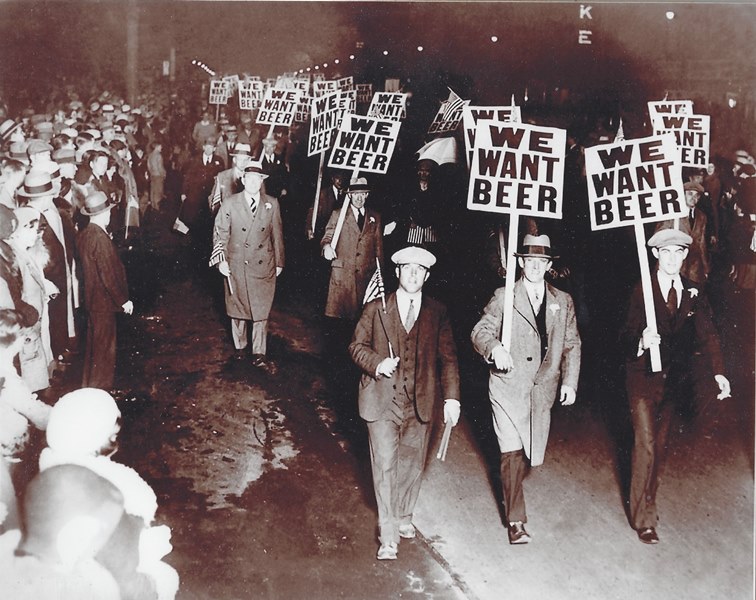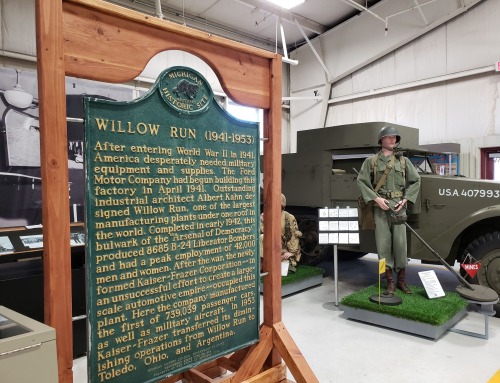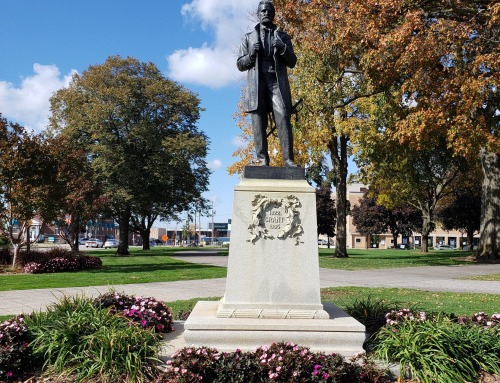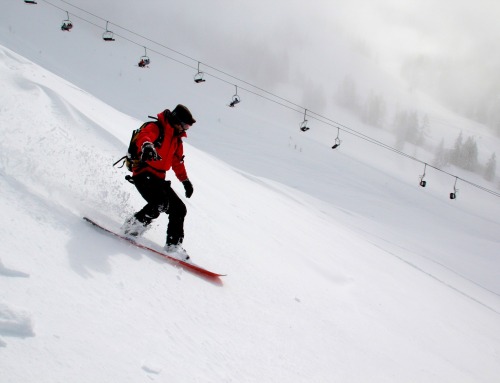The month of May marks the anniversary of Michigan Prohibition, which began on May 1, 1917. “But wait,” say those of you who know your Constitutional History. “Prohibition was the 18th Amendment and that took effect on January 17, 1920.” Well, my friends, the state of Michigan, which is now home to Beer City USA, passed a prohibition law three years before the Federal Government did.
Now, the idea for prohibition is not necessarily a bad one. Michigan’s church, business, and community leaders believed that a ban on the sale of alcoholic drinks would reduce crime and improve both family life and employee productivity. Many people also believed that alcohol was a gateway drug and would cause stunted growth and poor health. However, like many ideas sounding good on paper, this in reality is not always the case, because even when it is outlawed, people still want their alcohol, and when they cannot get it legally, they will get it elsewhere. This leads to rum-runners, bootleggers, and gangsters like Al Capone. In this case, it also led to a significant loss of jobs in Michigan.
The Michigan Anti-Saloon League played a meaningful role in creating public disapproval against the saloons, breweries, and any consumption of alcohol. In particular, the high-profile evangelist Reverend Billy Sunday of Iowa gave many fiery sermons against alcoholic beverages. Michigan Governor Chase Osbourn was another outspoken opponent to brewery-owned saloons. By 1907, several Michigan counties began going dry, starting with Van Buren County in the Southwest part of the state. By 1911, thirty-nine counties in the Great Lakes State had adopted local prohibition laws.
As soon as Michigan went officially dry on May 1, 1917, many local citizens began to take matters into their own hands. Bootleggers and smugglers formed their operations within hours of the law going into effect. Other citizens began making their own liquor or beer. The fines given to smugglers was a minor risk compared to the profits one could gain.
Though we Michiganders have had a troubled past with one of our neighbor states to the south, during our early days of prohibition, we forgave old grievances, and professional smuggling rings quickly began bringing illegal alcohol in from Toledo. In fact, so much was flowing into our state from Ohio that US 25, now known as the Dixie Highway, was then known as the Avenue de Booze.
On January 17, 1920, the US government passed the Nineteenth Amendment, which prohibited the sale, consumption and manufacturing of alcohol in the United States. With our supply from Ohio now cut off, bootleggers and rum-runners turned to Canada, accessing the Detroit River, Lake Sinclair, and other waterways between Michigan and Ontario. Smugglers used any means to get their liquor in undetected, including planes, trains, cars, trucks, and boats. More imaginative rum-runners used underwater sleds and funeral hearses. In fact, this area became known as the Windsor-Detroit Funnel. During the frigid winter months, smugglers were able to drive across the water, skate across with sleds full of alcohol behind them, and they would use ice skiffs to get their booze into Michigan.
One inventive smuggler built a split gas tank that could be filled with half gasoline and half liquor. Women would also get in on the game by strapping large canisters of alcohol to their legs and covering them with their skirts and coats.
The alcohol coming in from Canada via Detroit didn’t just stay in Michigan, it was distributed around the country. Michigan quickly became a major smuggling hub. Large vessels would dock in Windsor, Canada, and have documentation for South America, but they would simply drop their shipments of alcohol in Detroit as they passed. Rum-runners, which is a term that usually refers to smuggling over water as opposed to bootleggers, who smuggle alcohol over land, would unload the alcohol into a boat at the docks and then get their permit stamped by a customs official that they had bribed.
The Detroit Border Patrol tried to stop the smuggling, but was very unsuccessful. Michigan officials severely lacked the resources to stop the law-breaking. Many community leaders and law enforcement officers were not in agreement with prohibition, and took bribes for their silence. One evening, the Michigan State Police raided a speakeasy in Detroit and found 800 people inside, including a Michigan congressman, a sheriff, and Mayor John Smith.
Detroit was the heart of the illegal alcohol trade in all of America during Prohibition, with an estimated 75% of illegal alcohol in the country crossing over the Detroit River. By 1929, rum-running was considered Detroit’s second-largest industry, behind automotive. There were also between 16,000 and 25,000 speakeasies operating in the Detroit area alone.
Many large cities had issues with gangs during the Prohibition era, and Detroit was no exception. The most notorious in Michigan, the Purple Gang, grew to great power in the rum-running business. This was a gang that became so feared, that not even Al Capone wanted to encroach on its territory. Instead, he worked with them to bring Canadian whiskey to Chicago. The infamous Purple Gang was even immortalized in the Elvis Presley hit, Jailhouse Rock with the line, “The whole rhythm section was the Purple Gang. Let’s rock everybody, let’s rock.”
The Purple Gang was made up of mostly young Jewish immigrants whose parents had come from Russia and Poland. They started in the Hastings Street neighborhood in Detroit’s Lower East Side. The founding members all went to school together as boys, and the gang was led by brothers Abe, Joe, Raymond and Izzy Bernstein. They became thieves and pickpockets very early in their lives, but soon graduated to armed robbery, loan-sharking and extortion. The gang became quite feared during Prohibition by hijacking alcohol that had been smuggled by others across the Canadian border.
The Purple Gang controlled all of Detroit’s underworld, including gambling, liquor and the drug trade. They were invincible to law enforcement, as many witnesses were too terrified to testify in any criminal trials. The gang began to bring in hired muscle from other cities, such as New York and Chicago, but this led to disputes and turf wars between the members.
The gang began to dissolve in the early 1930s because of jealousy, egos, and the inter-gang strife. They also reportedly became more arrogant and made sloppy mistakes. In September of 1931, Purple Gang members Ray Bernstein, Harry Keywell and Irving Milberg killed three fellow members. Hymie Paul, Joe Sutker and Joe Lebowitz, who had been working against the gang in their own interests. They were invited to a so-called peace negotiation at the Collingwood Manor Apartment building. Similar to Chicago’s famed St. Valentine’s Day Massacre, it was a setup, and Paul, Sutker and Lebowitz were murdered in cold blood. Ray Bernstein, Keywell and Milberg were convicted and given multiple life-sentences.
Over the thirteen years of Prohibition, Detroit and hundreds of other cities found many problems with the law, including a loss of jobs, an increase in violence and crime, and law-abiding citizens losing their patience with the authorities for harassing them and raiding their homes. Some of these were problems the law was actually intended to eradicate. In 1933, Michigan reversed its own prohibition laws and was the first state in the country to ratify the 21st Amendment, which repealed Prohibition. Some counties and townships remained alcohol-free for many years afterward. In fact, Hudsonville, a town in Ottawa County, didn’t repeal its dry law until November of 2007, but is now home to a couple of breweries.
Leave it to our great state to be the first to outlaw alcohol and the first to make it legal again. The Great Lakes State is now well known for our many local breweries especially in Beer City USA, better known as Grand Rapids. We are also known for our many wineries, like those along the shores of Lake Michigan and throughout the state. These establishments have brought in more prosperity and tourism to our beautiful state. So the next time you sit back and crack open a cold one, think about our state’s history with Prohibition and its repeal. Cheers, reader! This one’s for you.







Leave A Comment
You must be logged in to post a comment.